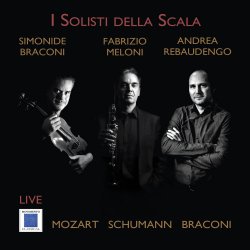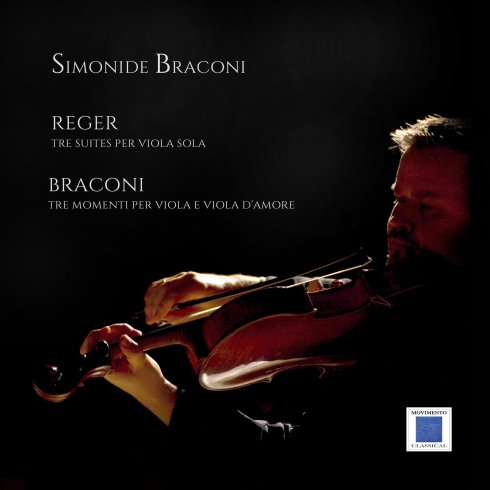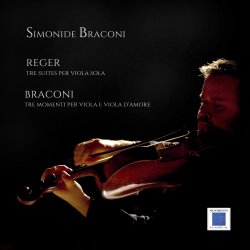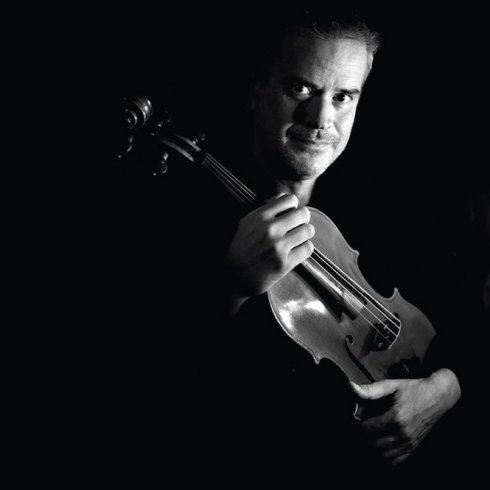

REGER
THREE SU IT ES FOR VIOLA SOLO
Max Reger (1873-1916) is sometimes the victim of a senseless cliché, according to which his music is twisted and hypertrophic. The fact that he wasa great master of counterpoint has tao often overshadowed other aspects ofhis art: hissensitivity and lyricism that unites to Alban Berg, from whom he was highly esteemed. Those who consider him only as a reassuring Kapellmeister should remember that the immense catalog of this Bavarian Catholic, who died at the age of 43, includes visionary works such as the Four Symphonic Poems from Bbcklin, the Fantasia for organ "Inferno" op. 57 or a lieder production (229 titles) very far from the limiting label ofneo classical or neo-baroque. If it is true that the world of Bach and Telemann, from whose fugues he was inspired by far memorable cycles ofVariations, represents far Reger a sort oflonged-far golden age, it should be empha sized that he was by no means a conservative: fully aware ofthe chromatic revolution ofTristan's Wagner, Reger even went beyond the harmonic experiments of Bruckner or Wolf, to the frontiers of atonality and serial think ing. The image ofthe Teuton pedant is also denied by works that are similar to the more delicate impressionism, with a predilection far pianissimo dynamics.
In his works far solo string instrument (violin, viola, celio) Reger might appear nostalgie far the past. In reality,
his referring to the practice of Bach or Biber makes him, paradoxically , an inno vato r: he is, in fact, among the first to take up this tradition, except far isolated cases of a mar kedly virtuosic mold. The suite and sonata far solo string instr ument , after Reger, will have illustrious prosecutors in the twentieth century - think far the celio in Britten or Kodél.ly, far the viola in Hindemith or Ligeti, far the violin in Bart6k or Prokofev.
Reger, however, is the first, with Ysaye, to return systematically to this practice, with the faur violin sonatas op. 42 and seven o'clock in op. 91, which often end, in the Baroque ma nner, with a Chaconne. Far solo violin are also the Preludes and Fugues op. 117 and op. 1 31a. All the work 131, which also includes the Suites far viola op. 131d, constitutes a sort of compendium of the technical and expressive possibilities of the solo string instru ment: op.131b presents three diptychs far two violins in the antique style, op. 131c consists ofthree Suites far celio. If there is one work that dispels the false myth of a heavy and prolix Reger, it is precisely the collection of the Viola Suites: in these works he demonstrates that he possesses the gift of synthesis. These are expressive and meaningful works, mainly monodie or with a counterpoint reduced mostly to two voices (it is no coinci dence that Reger, contrary to what happens in works far violin or celio only, does not insert fugues).
However , this apparent simplicity hides a sort of underlying harmonic thought: it is as if the composer, behind
the purity of a simple line, makes us imagine the changing harmonies underlying it.
The Suite n. 1, in G minor, opens with a very sustained, expressive movement in which the recurring supports outline a sort of reinterpretation of the eighteenth-century pathetic style. The next Vivace, characterized by a vital trochaic rhythm and the extensive use of double strings, is between the serious and the facetious, with a hu morous vein accentuated by the surprises of the dynamic contrasts. The centrai trio, with the evocative "horn fifths", is more placid. Traces of the Brahmsian sound imaginary clearly shine through.The sustained Andante al ternates monody and bichords: in this movement there is a particular warmth and a loving sense of Heimat, an untranslatable word, if not perhaps with the Slavic domovina. Not just home or country, but the feeling con nected to one's origins, the security and happiness related to the sense of identification and at the same time the perception of having lost that belonging: therefore, in Reger's Bachian references there is a subtle nostalgia, a sense ofpeace mixed with a subtle uneasiness. However, the Suite ends with the return to a healthy propulsive force, that a lively perpetuai motion's that ends gloriously.
The Suite n. 2, in D major, has an overall bright colour. The first movement, With moto, is characterized by ascending quatrain motifs and a sweetly playful vein: without parody, as in search of a good old time. The An dante, always expressive, seems to referto Brahms with its sighing motifs, and is characterized by a progressive agogic climax, before getting lost in a final trill that reaches the pianissimo. The epigraphic Allegretto, a slightly edgy Scherzo, is interspersed with an "almost less moved" trio softened by sweet bichords. The finale, Vivace, is an imaginative combinatorial game made up of rhythmic trompe l'ceil and daring rope jumps: a sort of jig with marked dynamic contrasts and echo effects, concludes the Suite in an atmosphere of joy.
The Suite n. 3, in E minor, has a more painful character: certainly not an abysmal despair; rather a composed supplication, as reflected in the initial Moderato, full of nobility and expression. In the Vivace, the different regis ters seem to correspond to as many voices that converse. A more pronounced Sehnsucht is manifested in the in spired Adagio, opened by a motifthat recalls the Lebewohl (Addio) ofthe Sonata op. Sla by Beethoven. But the Allegro lively ending, with its "acciaccature", the detached bichords, the jumping rhythms of a "son of the muses", the jumps a little jokey to Till Eulenspiegel, brings us back to play and joy: which for Reger is, above ali,, the joy of music itself.
BRACONI
THREE MOMENTS FOR VIOLA D'AMORE
Simonide Braconi (1971), has for years joined his career as a viola and viola d'amore concert player with that of a composer. Trained at the Santa Cecilia Conservatory in Rome under the guidance of Teresa Procaccini, his production includes music for solo instrument (especially for viola), chamber music and orchestra. His "Back to the viola" for viol ensemble was premiered at the Teatro alla Scala in Milan and at the Berlin Philarmonie inter preted by the violas of the Berliner Philarmoniker. Among his recent commissions, those of the Unione Musicale of Turin and the Friends of Music of Perugia stand out.
His music is published by MAP and Sonzogno.
THE THREE MOMENTS want to represent in musie the three engines that altogether condition the action of the human being, that is to say, REASON with its well-structured "constant gait" and a controlled rhythmic attitude, INSTINCT, a crazy succession of biscromes in which the instrumental virtuosity is taken to extremes and, finally, the FEELING. For this final piece Braconi relies on the ethereal and delicate timbre of the viola d'amore, whose 7 resonance strings vibrate stimulated by the main ones; a sort of "affective symbiosis" that develops in a long recitative with an improvisational character, catapulting the listener into a dreamlike and meditative parallel di mension.



Simonide Braconi
Viola
Born in 1971, he graduated first-class honour in Rome and in Freiburg (Germany), studying respectively with Prof. S.Esposito and K.Kashkashian.
He continued his training under the guidance of renewed soloists such as Y.Bashmet (Acc.Chigiana) and B.Giuranna (Acc."W. Stauffer" in Cremona).
Winner of several competitions, prized in the 1994 Lionel Tertis Competition,he got in 1995 a special prize from the Kulturkreis der deutschen Wirtschaft in Koln.
As a soloist and chamber musician he has recorded for Vigiesse, Thymallus, Agorà, Tudor, Dad, Rhona, Stradivarius, Dynamic, Brilliant, for italian Radio3 and for the classical reviews CD Classica, Suonare news and Amadeus (Brahms sonates op. 120).
Principal viola in the Orchestre des jeunes de la Mediterranée, then member of the European Community Youth Orchestra (ECYO), in 1994 he was selected by M. Riccardo Muti as principal viola soloist at the Teatro alla Scala and for the Orchestra Filarmonica della Scala of Milan.He's also member of the orchestra of the Lucern Festival and has been invited to play in the Berliner Philarmoniker orchestra. He often performs in duo with his brother pianist.
Togheter with other section's leaders of the orchestra, he recently founded the Quartetto d' archi della Scala.
Invited as member of jury in several international competitions (Geneva).He is regularly invited as professor to hold masterclasses and concerts at important festivals (Arts Academy in Rome, Festival delle citta’ in Portogruaro, Gubbio Festival, Accademia "T. Varga" in Sion, Associazione Napolinova, Accademia Malibran, Accademia di musica in Pinerolo,Sebino summercourse).
In chamber music or as a soloist he performed with artist such as J. Rachlin, P. Vernikov, M. Quarta, S. Accardo, U. Ughi, E. Dindo,E. Pahud, Sonia Ganassi, Jose Carreras . In 2003 he performed the Kammermusik N. 5 (concert for viola) with the Orchestra Filarmonica della Scala under the conducting of M. W. Sawallisch and in 2005 the Mozart’s Sinfonia Concertante with M. Riccardo Muti and the orchestra Cherubini .
He's also soloist with viola d'amore; as a composer several works are published by Sonzogno, MAP musical editions and several premiere have been performed in the teatro Alla Scala and Philarmonie of Berlin.
He plays a “Giovanni Gagliano” viola (1800).
